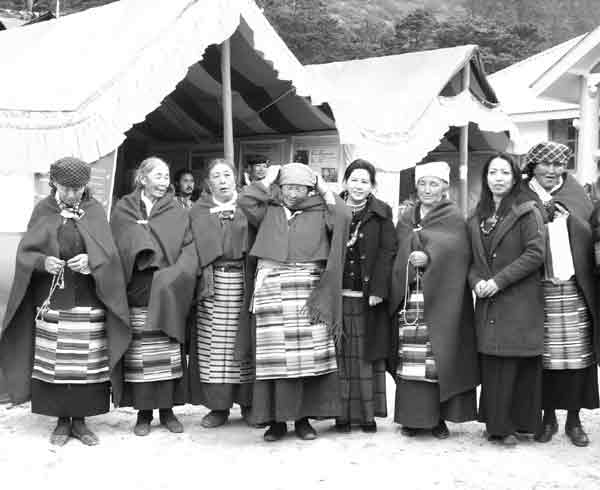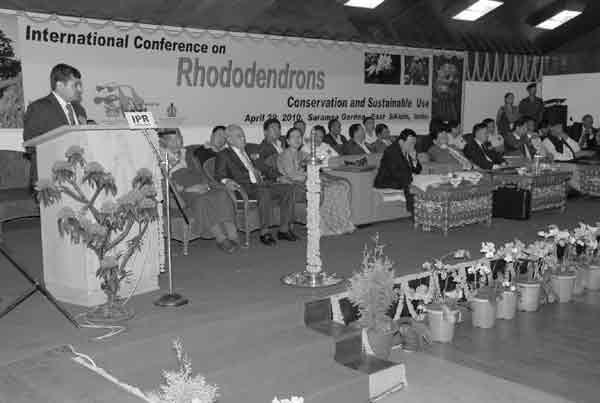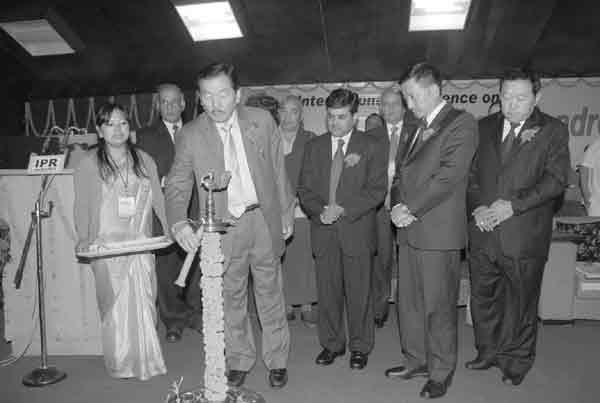JARS v64n3 - Sikkim International Rhododendron Festival 2010
Sikkim International Rhododendron Festival 2010
Keshab C. Pradhan
Tadong, Sikkim
India

The Sikkim International Rhododendron Festival was conceived in mid 2008 and with the accompaniment of traditional dances and music, commenced on April 25, 2010, at the Singba Rhododendron Sanctuary in the Yumthang Valley in North Sikkim. It was opened by the Governor of Sikkim, who along with a host of Ministers and delegates from both within and outside the country, participated in the time-honoured tradition of offering prayers to the deities at Chuba Lhakang in the Dombang Valley. The rhododendrons were at their best, indeed the finest in the living memory, and their blooms mesmerized all those attending the Festival.
Dr. Wolfgang Spethmann from Germany noted, "One highlight was the special program for international delegates, notably the trips to Lachung and Lachen to see rhododendrons in the wild. We never before saw so many wild species flowering at the same time. The opening ceremony was a great event and we were impressed that so many people came by car to the Shingba Sanctuary. You should be proud that so many Ministers and your Governor supported this event, and in so doing Sikkim's rhododendrons." Unfortunately, Pawan Chamling, the Chief Minister of the State who visio ned the event back in 2008, and who gave members of the Forest Department and Sikkim Tourism directives to help in its organization, was unable to attend the opening ceremony. His vision of making rhododendron flowering a major eco-tourism product was however well implemented, with around 500 vehicles going to the Valley every day for a month. Many houses operated as "home-stays" to supplement the meager commercial quality accommodations available. In the 19th century, J.D. Hooker helped make Sikkim synonymous with rhododendrons, and seeing them blooming at the same locations as Hooker did way back in 1849 was very special. Forest Service members helped greatly, such as through planning vehicle tour routes, labeling plants, and laying out hiking footpaths. The Directorate of Handicrafts encouraged the development of souvenirs, including artistically designed flower button-flowers made out of cut and painted bamboo sheaths as leaves and dyed linens depicting Rhododendron arboreum and R. niveum ; rhododendrons carved in wooden Sikkimese tables, called "Chokche"; and trusses of rhododendrons depicted in both floor rugs and in handmade paper, which were all well appreciated. The head waters of the Yumthang River were stocked with trout by the Sikkim Anglers' Association, again to the delight of visitors. The food festival catered to all tastes and was organized by local people who served food in their colourful traditional clothes, all with the hospitality and grace for which Sikkim is well known. The Travel Agents Association of Sikkim organized various activities such as mountain biking, and bird watching was organized by the Sikkim Ornithological Society.

|
|
Nuns of Lachung at Singba, with
Namrata Thapa, Director of Handicrafts (fifth from left).
Photo by Keshab C. Pradhan |
The Conference session "Rhododendrons: Conservation and Sustainable Use" was held on April 29, the last day of the Festival, at the renovated Saramsa Garden (established by the author's father in 1920 for experimental horticultural and medical plant cultivation) and was attended by the Chief Minister of the State, Pawan Chamling. His address was thought provoking and indicated his desire to keep Sikkim pollution-free through the banning of usage of all chemical fertilizers and pesticides in its farming systems, encouraging tourism that respected natural ecosystems, and above all, protection of Sikkim's rich biodiversity of flora and fauna.

|

|
|
|
Bhim Dhungel, Minister for Forests,
Environment and
Wildlife Management addresses the gathering. Photo by Keshab C. Pradhan |
Pawan Chamling, Chief Minister of Sikkim,
inaugurates the
Conference by lighting the ceremonial lamp. Photo by Keshab C. Pradhan |
The status of rhododendrons in their respective countries was given by conference delegates from Germany, the Netherlands, Sweden, Bhutan and India. A banquet hosted by the Minister of Forests was held at the May Fair Hotel, and parting gifts were given to all delegates. Many had come as strangers just a week earlier, but all went home as friends, all because of this fabulous rose-tree, the rhododendron. A highlight of the Festival, besides the adventurous road journey chauffeured by dare-devil Sikkimese drivers, to our friends from abroad was a set of four limited-edition watercolour painting prints by a talented Sikkimese lady, Bathsheba Hartrey, based in England.
A group of International Dendrological Society members led by its President, Sir Richard Storey, attended, with members from New Zealand, Turkey, Switzerland, Ireland, Belgium and the UK. There were all die-hard dendrologists, and it was a real delight to mingle and talk with them. They are a breed by themselves, all able literally to tear a tree apart and to learn its every detail. Vicomte Philippe de Spoelberch's summary of his observations stood out: "I have had the chance to visit the Himalayas and southwest China on more than half a dozen occasions. Only twice did a find such a concentration and richness of flora: the first was in the well known Cangshan mountain chain above Dali in Yunnan and recently in the province of Sikkim in India. If Bhutan is the most protected forest environment, Sikkim has the most dense and varied presence of Rhododendron . During ten days of botanizing (28 April- 9 May 2010), we recognized some 23 rhododendron species, and I believe that we missed a number of species in the Lapponica Section at higher elevations. Obviously, a longer period in the country would have allowed us to see most of the approximately 35 species found in Sikkim. Our first encounter was with R. arboreum . At lower levels, it reminded me of subsp. delavayi as seen in Yunnan with its bright scarlet colour, but this distinction is not made in Sikkim. We later saw a great specimen at the base of a cliff at Lachung (Dombang Valley) but otherwise the flowering of this species was over. R. dalhousiae appeared in oak trees ( Quercus lamellosa ) near Rabongla, but it was not that common. I expected to see more R. falconeri but we only saw one good specimen on the way to Tsango Lake above a lovely cascade, and a cliff next to the cascade displayed a vigorous R. arboreum . A greater concentration of rhododendrons was found in the Kyongnosla Alpine sanctuary. Clearly in the surrounding areas, grazing pressure has badly diminished the forest and the diversity of the vegetation. In the sanctuary, we found lovely R. niveum (National plant of Sikkim), a small falconeri , many thomsonii , and campanulatum was also dominant. A short 40-minute visit may have failed to allow us more encounters, and higher up the path would surely yield further finds. The Yumthang valley between 2700 to 4000 m [8800 to 13,100 ft] yielded many good plants: between 3000 and 3250 [9800 10,700 ft] we would see R. ciliatum (occasionally), campanulatum , campylocarpum , cinnabarinum , hodgsonii , glaucophyllum , and fulgens . We also found our first hybrid between R. thomsonii and campylocarpum , which we were to see again later on the way to Thangu. I was particularly impressed by the variability of the cinnabarinum flowers from yellow-orange to deep red-purple. Plants were dense and floriferous, a great change from our diseased plants in Western Europe, with no trace of powdery mildew. Rhododendron hodgsonii was dominant around Yumthang under the beautiful canopy of Abies densa , with occasional R. fulgens . Higher up, we found R. lepidotum with last year's seed pods and then masses of R. wightii on the slopes at 4000 m, well above the tree line. Among the boulders, R. anthopogon would find a niche right between the R. wightii . A rhododendron from the Lapponica section grew on the rocks on a thin layer of moss.
The Dombang valley, just a few miles from Lachung, contains a few very sacred places which have allowed some great trees to be protected and reach champion tree heights - Abies densa , Picea spinulosa , Tsuga dumosa , and Larix griffithii . We all hoped that these monumental but small woodlands would continue to be protected. Under these trees, we were to find some R. ciliatum and pendulum , more cinnabarinum and lovely Enkianthus .
Our last major excursion was North of Lachen and past Thangu towards Lunglak-La. Grazing was obvious all around us and few plants would survive, but rhododendrons do seem to avoid the tooth of yak and goats. Dominant were R. campanulatum , campylocarpum , wightii and thomsonii . Below Thangu in heavily grazed and treeless lands we found R. anthopogon and setosum . Just above Thangu along a stream, we found many rhododendrons on the right bank. It would be well interesting to establish another sanctuary in this area. Higher up on the way to the Lunglak pass we were to find lovely R. aeruginosum with wonderful brown orange indumentums and strikingly red mauve flowers. They had settled on the boulders of a gigantic moraine. On the other side of the valley, the slopes were entirely covered with R. wightii . Our visit to Sikkim would not have been possible without the kind and effective efforts of both Keshab C. and Sailesh Pradhan who organized and planned all the details of our visit, including obtained all the permissions for our visit to these sensitive military areas. The higher altitude areas are not open to the general tourist and we would have missed some important species if we had not benefited from their excellent contacts and preparations. Our drivers also deserve a word of praise. High altitude roads are often in poor condition and narrow dirt tracks were common. They drove us safely to our destinations". Sikkim's rhododendrons came to the fore following J.D. Hooker's visit to Sikkim in 1848. During the two years of his sojourn in the Sikkim Himalayas, he found 24 rhododendron species new to science. This discovery, unrivalled at that time in the exploration for rhododendrons, was followed by Hooker's (1949) publication of his illustrated book titled Rhododendrons of Sikkim Himalaya . This led to two types of plant fanatics: plant propagators and plant explorers. English enthusiasts funded adventurous plant hunters to explore all corners of the Himalayas in search of exquisite species. By 1900, some 100 temperate rhododendron species had been identified and today, over 400 species come from this area, with China alone claiming over 300 species. In Europe, America and Australia, a host of people were engaged in creating new hybrids with desired shapes, sizes and flower characteristics. In particular, R. arboreum and R. griffithianum from Sikkim gave many hybrids their truss size and colour, while R. yakushimanum from China gave a desired plant form. Despite all these discoveries, because of Hooker, plants from Sikkim are still looked upon as some of the earliest influences on modern rhododendron culture in the temperate regions of the world. It is thus befitting that the State Government of Sikkim thought fit to hold an International Rhododendron Festival to showcase not only its floral wealth but also its political will to conserve this prized heritage in their natural habitats in this International Year of Biodiversity. When I was asked to invite delegates from abroad, my first thought was of the Scandinavian countries of Sweden and Finland, which had strong ties with Lachung and Lachen. Missionaries from these countries were instrumental to bringing new ways to blend with the region's unique traditions at a time when Sikkim was first encountering industrial societies. People from the adjoining countries of Norway, Denmark, the Netherlands and Germany soon followed. Sadly, the 2010 volcanic eruption in Iceland played havoc with the air travel plans of many potential delegates, and many had to cancel their visits. Many of those who were able to attend had tales to tell of their travel difficulties - driving miles to reach the nearest airport fit to operate and the hassles they experienced in making connecting flights. Many did ultimately make it to Sikkim though, and it was a rare sight to see the flags of so many European countries flying high against a perfect mountain background with rhododendrons at their best. Delegates from both within India and abroad went home with fond memories of Sikkim's traditional hospitality and the rhododendrons that welcomed them.Reference
Hooker, J.D. 1849 (1979 reprint). Rhododendron of Sikkim Himalaya . Bishen Singh Mahendra Pal Singh: 33 p.
